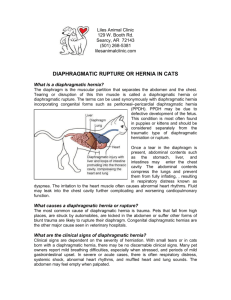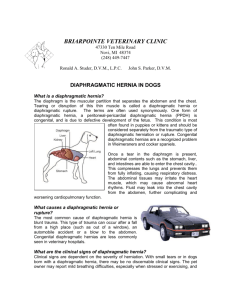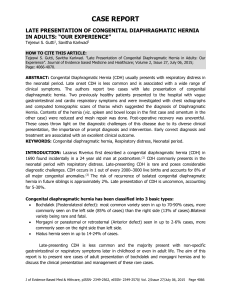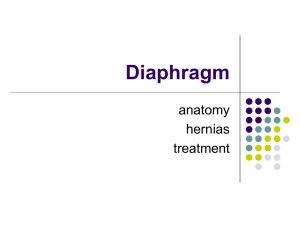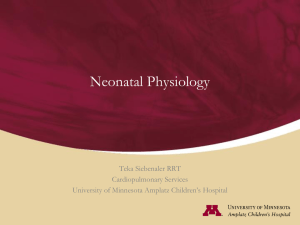Congenital Diaphragmetic Hernia
advertisement
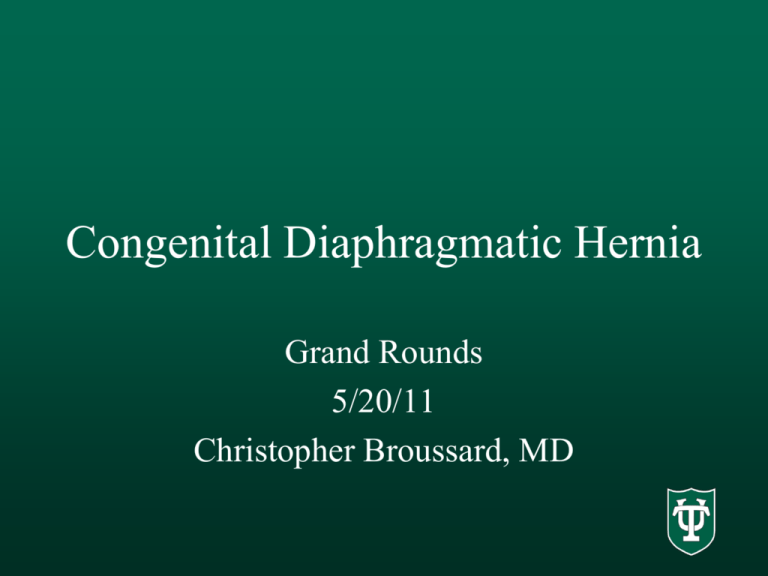
Congenital Diaphragmatic Hernia Grand Rounds 5/20/11 Christopher Broussard, MD Lecture Outline • • • • • Case Report Pathophysiology Management Perioperative Planning Board Review Example Case • Should we fix it immediately? • Not so fast Case Presentation • • • • Pt born via C/S at 39 3/7 weeks Apgars 5&7 Pregnancy complicated by placenta previa Third trimester ultrasound demonstrated polyhydramnios - not CDH • Pt born in outlying community hospital, stabilized and transferred to Tulane. • Large diaphragmatic hernia with R Lung collapse on CXR. Case Presentation • • • • • DOL #1 PSV ABG 7.18/62/78.6/24/-6.5 on 90% O2 A-a gradient 500mmHg Echo: PDA with R L shunt, PFO, PASP 68mmHg (suprasystemic), enlarged RA and RV. Case Presentation • • • • DOL # 2 ECMO started in the NICU Treatment with NO Pulmonary vasodilators – Sildenafil – Bosentan • Dobutamine Overview of CDH • • • • Incidence - 1/2500 – 1/5000 Male/Female ratio – 2:1 Left/Right – 5:1 Types – Posterolateral (Bochdalek): 80% – Anterior (Morgagni): 2% – Paraesophageal: 15-20% Embryologic Development • Diaphragm, lungs and GI tract begin development at 4 weeks. • Pleuroperitoneal canal separate by 9th week • Rotation and settling of midgut before fusion of diaphragm • Limited thoracic space for lung growth • Genetic vs. environmental Review of Fetal Circulation • High resistance pulmonary circuit • Low resistance systemic circuit • R > L shunt via foramen ovale and ductus arteriosus Pathophysiology Pathophysiology • Pulmonary Hypertension – – – – Pulmonary hypoplasia Thickened tunica media and adventita Hypoxemia, hypercarbia and acidosis Inflammatory mediators (TxA2, LT C4 & D4) • Suprasystemic pulmonary pressures to L shunt via PDA and PFO • Poor cardiac output due to small LV R CHD SIDS Diagnosis • Typically prenatal (40%-60% by Ultrasound) • Classic Triad – cyanosis, dyspnea, apparent dextrocardia. • Scaphoid abdomen • Bulging chest • Variable Presentation Immediate Management • • • • • Determine adequacy of ventilation Gastric decompression Limit mask ventilation Intubation Gentle ventilation Associated Abnormalities • • • • • 10-40% overall, often coexist Cardiovascular 13-23% CNS 28% GI 20% GU 15% Migliazza L, et al. J Pediatr Surg 2007 Prognosis • Mortality 20-60% • Stege G, et al. Pediatrics 2003 – Case selection bias – Additional defects – 79% v 30% • Prenatal findings – LHR, PA diameter, thoracic liver Timing of Surgery • Why would repair worsen pulmonary compliance? – Increased intra abdominal pressure – Decreased chest wall compliance Timing of Surgery • Historical Management – Hyperventilate with 100% O2 – Immediate surgical repair – Use of ECMO post operatively Timing of Surgery • Nakayama DK, et al. J Pediatr 1991 – Medical stabilization (2-11 days) vs. emergency surgery – Decreased mortality – Improvement noted in pulmonary mechanics Protective Ventilation • Wung JT, et al. J Pediatr Surg 1995 – – – – Spontaneous, pressure support ventilation Permissive Hypercapnia Preductal saturation >90% Improved survival and decreased need for ECMO with delayed surgery HFOV • Typically used as rescue therapy in CDH • 3.5-15Hz HFOV • No prospective trials of HFOV vs. traditional ventilation in CDH • Migliazza L, et al. J Pediatr Surg 2007 – Retrospective review of 111 cases intended to look at prognostic factors. – HFOV used as primary mode of ventilation • Bhuta T, et al. Cochrane Database Syst Rev 2001 – Infants with respiratory failure, all types – No survival improvement Nitric Oxide • Crosses cell membrane, increases cGMP concentration • Selective pulmonary vasodilator • Free radical with short half life • Potential for methemoglobinemia and accumulation of NO2 with prolonged use. Nitric Oxide • Controversial in CDH • Finer NN, Barrington KJ. Cochrane Database Syst Rev 2006 – Supports use of Nitric Oxide in PPH hypoxic respiratory failure • NINOS. Pediatrics 1997 – No improvement in mortality – Increased risk of ECMO ECMO • Historically central in treatment of CDH • Utilization has fallen in current practice • Is ECMO a good idea for this patient? ECMO • CDH Study Group. J Pediatr Surg 1999 – mortality data for ECMO vs. no ECMO based upon predicted mortality. – Birth weight and Apgar score – ECMO improved survival in infants with >80% predicted mortality only. – Worse mortality in the remainder of the patients. ECMO • Wilson JM, et al. J Pediatr Surg 1997 – Retrospective review of cases at two tertiary centers. – Toronto – HFOV as rescue – Boston – ECMO as rescue – Similar mortality data between the two centers. ECMO • A-a gradient 600mgHg • PIP > 25cmH2O • Oxygenation Index – MAP×FiO2/PaO2 – >40 Case Presentation • Serial echocardiograms decreased PAP, reversal of PFO and PAD shunts L R • ECMO weaned on DOL#12 • Sepsis/DIC – delay • Closure on DOL#16 Preoperative Evaluation • • • • • • • 4kg NO(40ppm), Sildenafil, Bosentan Dopamine 12 mcg/Kg/min Fentanyl/versed TPN IJ central line, UAC PRVC RR 40, PEEP 5, TV 17 Preoperative Preparation • • • • • • • Warm room, warm fluids CVP, Art line Maintain ventilator settings/NO Paralysis Maintain ICU drips (including TPN) Adequate volume access Two pulse oximeters Operative Details • • • • • • Subcostal incision Hepatic Pulmonary fusion Thoracotomy Liver resection Gore-Tex patch 80% defect in R diaphragm Anesthetic Management • • • • • EBL 400 mL PRBC 200 mL FFP 160 mL Plts 40 mL UOP 20 mL Postoperative Course • • • • • • • Pneumothorax BPD Tracheostomy Ventilator dependence Nissen Fundoplication G-Tube Discharged at 3 months Hepatic Pulmonary Fusion • Schmuel K, et al. J Pediatr Surg 1998 • Jeffrey W, et al. J Pediatr Surg 2010 – – – – Case presentation plus literature review Majority of cases identified intraoperatively 50% success rate in separation MRI identified as modality most likely to Complications in CDH survivors • Respiratory – obstructive disease, poor exercise tolerance • GI – oral aversion, GERD, failure to thrive • Neuro – developmental delay, sensorineural hearing loss • Musculoskeletal – pectus excavatum, scoliosis • Reherniation (10%) Review • US is only 50% sensitive for prenatal Diagnosis • Early recognition and prompt treatment is essential • The use of lung protective ventilation is the most effective therapy. Appropriate management of a neonate born with congenital diaphragmatic hernia (CDH) should include A. Ventilation of the lungs with a bag and mask to keep saturation greater than 95% B. Insertion of an orogastric tube C. Expansion of the hypoplastic lung with positivepressure ventilation D. Hyperventilation to keep the PaCO2 below 40 and pH greater than 7.40 E. Rapid transport to the operating room for surgical correction Appropriate management of a neonate born with congenital diaphragmatic hernia (CDH) should include B. Insertion of an orogastric tube Congenital Diaphragmatic Hernia may likely be associated with all of the following EXCEPT A. VSD B. Meningomyelocele C. Tetralogy of Fallot D. Gastroschisis E. Duodenal Atresia Congenital Diaphragmatic Hernia may likely be associated with all of the following EXCEPT D. Gastroschisis References • • • • • • • Yao SF, Stein D, Savarese J: Congenital Diaphragmatic Hernia. In: Yao and Artusio's Problem Oriented Anesthesia. Yao, F, editor. 6th ed.; 2008. p. 115-129 Motoyama & Davis: Smith's Anesthesia for Infants and Children, 8th ed. Yamataka P, Puri P. Pulmonary Artery Structural Changes in Pulmonary Hypertension Complicating Congenital Diaphragmatic Hernia. Journal of Pediatric Surgery, Vol32, No 3 (March), 1997: pp 387390 Migliazza L, et al. Retrospective study of 111 cases of congenital diaphragmatic hernia treated with early high-frequency oscillatory ventilation and presurgical stabilization, Journal of Pediatric Surgery, Volume 42, Issue 9, September 2007 Nakayama D.K., Motoyama E.K., Tagge E.M.: Effect of preoperative stabilization on respiratory system compliance and outcome in newborn infants with congenital diaphragmatic hernia. J Pediatr 1991; 118:793-799. Wung JT, Sahni R, Moffitt ST et al. Congenital diaphragmatic hernia: survival treated with very delayed surgery, spontaneous respiration and no chest tube. J Pediatr Surg 1995; 30: 406–409. Bhuta T, Clark RH, Henderson- Smart DJ. Rescue high frequency oscillatory ventilation vs conventional ventilation for infants with severe pulmonary dysfunction born at or near term. Cochrane Database Syst Rev 2001; 1: CD0002974 References • • • • • • • Finer NN, Barrington KJ. Nitric oxide for respiratory failure in infants born at or near term. Cochrane Database Syst Rev 2006; 4: CD000399 de Buys Roessingh AS, Dinh-Xuan AT (2009) Congenital diaphragmatic hernia: current status and review of the literature. Eur J Pediatr 168(4):393–406 Neonatal Inhaled Nitric Oxide Study Group, Inhaled nitric oxide and hypoxic respiratory failure in infants with congenital diaphragmatic hernia, Pediatrics 99 (1997), pp. 838–845. The Congenital Diaphragmatic Hernia Study Group. Does extracorporeal membrane oxygenation improve survival in neonates with congenital diaphragmatic hernia? J Pediatr Surg 1999; 34: 720– 725 Azarow K., Messineo A., Pearl R., et al: Congenital diaphragmatic hernia—a tale of two cities: the Toronto experience. J Pediatr Surg 1997; 32:395-400. Wilson J.M., Lund D.P., Lillehei C.W., et al: Congenital diaphragmatic hernia—a tale of two cities: the Boston experience. J Pediatr Surg 1997; 32:401-405. Katz S, Kidron D, Litmanovitz I, et al. Fibrous fusion between the liver and the lung: an unusual complication of right congenital diaphragmatic hernia. J Pediatr Surg 1998;33:766-7 References • • Keller RL, Aaroz PA, Hawgood S, et al. MR imaging of hepatic pulmonary fusion in neonates. AJR Am J Roentgenol 2003;180: 438-40. Gander JW, Kadenhe-Chiweshe A, Fisher C, et al. Hepatic pulmonary fusion in an infant with a right-sided congenital diaphragmatic hernia and contralateral mediastinal shift . Journal of Pediatric Surgery (2010) 45, 265–268



